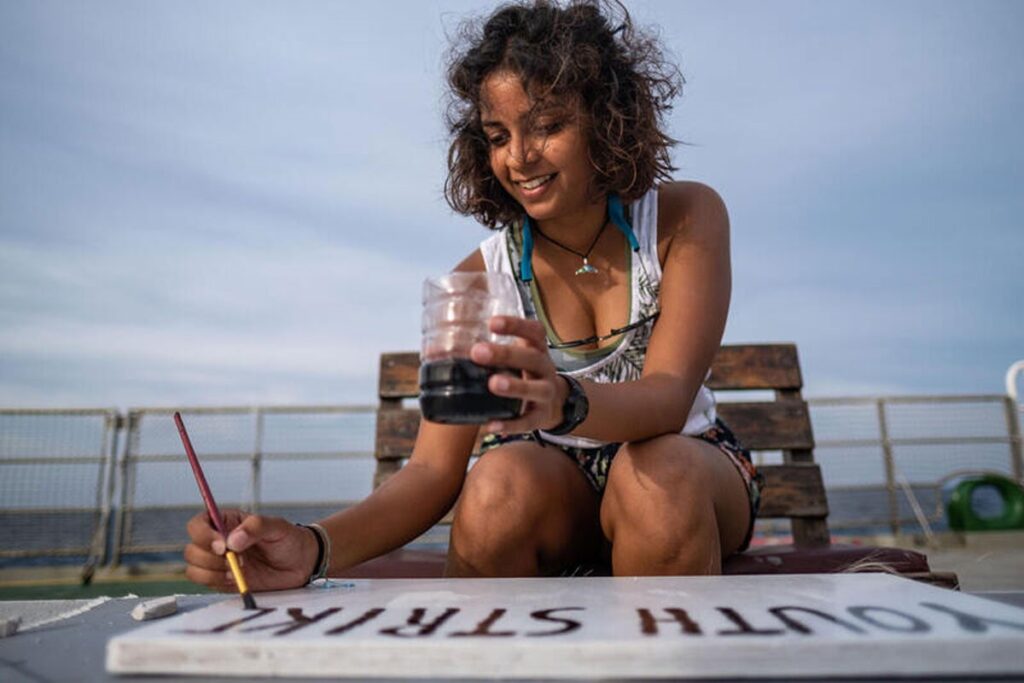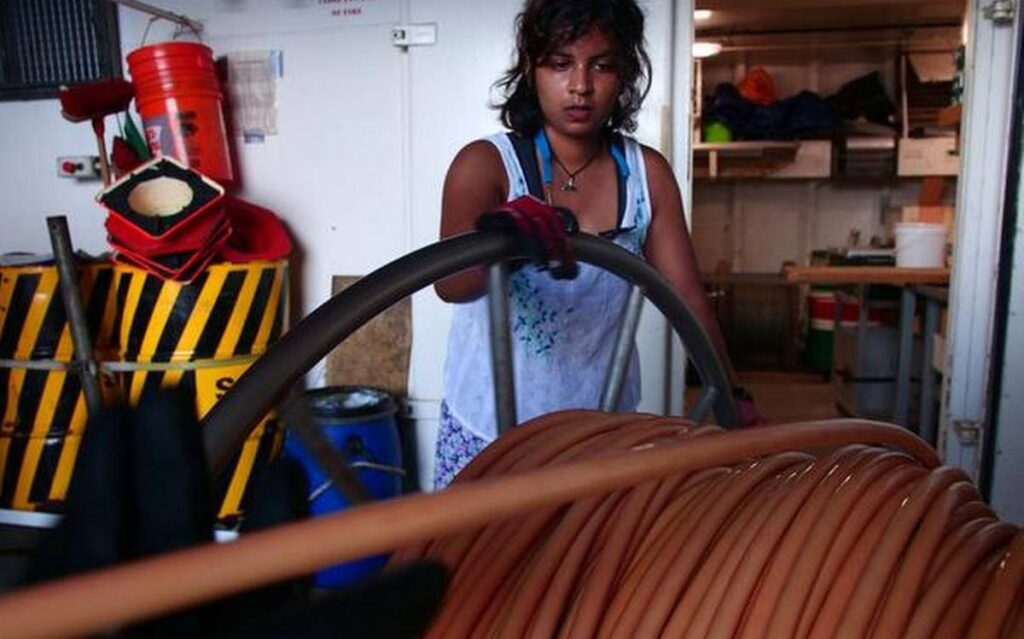Shaama Sandooyea | Mauritian Climate Activist
Shaama Sandooyea organized the world’s first underwater climate strike in the heart of the Indian Ocean. This event took place at Saya de Malha, 735 kilometers off the coast of Seychelles, a critical climate site due to its vast sea grasslands. On March 19th, the 24-year-old marine scientist donned a snorkel and dove beneath the choppy waves while holding a sign reading “Youth Strike for Climate” and “Nou Reklam Lazistis Klimatik” (We Demand Climate Justice). Images of the protest went viral on social media.
Where did the novel idea of an underwater protest come from, and what were your objectives for it ?
We were on the Arctic Sunrise with Greenpeace for a scientific expedition to Saya de Malha. This expedition was part of the “Protect the Oceans” campaign, which aims to protect 30% of the world’s oceans by 2030, and our goal was to study biodiversity. The seafloor was densely covered with seagrasses, and the Saya de Malha is known to have the world’s largest seagrass meadow. They have a significant impact on the climate and marine life. As a climate activist, holding an underwater strike at the Saya de Malha to demand climate action through ocean protection made sense. The objectives were to raise awareness about the Saya de Malha seagrasses and the need to protect them, as well as to call on world leaders and governments to protect this area from industrial fishing, marine pollution, oil and gas industries, and other stressors.
Can you describe the visuals you saw when you took your first plunge beneath the waves for the protest?
When I went to protest, the ocean was quite choppy, so it was difficult. I couldn’t see much of the seafloor from the surface because it was 20 meters deep. Then I began diving, and as I progressed, the seafloor became clearer and clearer, and I could see a dense seagrass meadow with leaves swaying with the current. Within the meadow, there were some sandy patches and corals growing, as well as schools of fish swimming around. It was breathtaking to see such a pristine seagrass meadow, which has allowed corals to grow and various fish species to thrive.

Why do you place such a premium on the preservation of seagrass?
Seagrasses are critical in the fight against climate change. They are underwater marine plants that cover less than 0.2 percent of the world’s ocean floor but sequester 10% of the ocean’s carbon each year. Seagrasses absorb carbon 35 times faster than tropical rainforests and store carbon in sediments on the ocean floor much longer than tropical rainforest trees that store carbon in soil. Adding to that, many fish species, sea turtles, starfish, sharks, and dolphins call seagrasses home and nurseries, so they must be preserved.
Did you anticipate such a strong global response to this movement? Even Swedish environmental activist, Greta Thunberg has taken notice of your climate strike; how do you feel about it?
We were hoping, at the very least, for a strong global response. I’m glad she saw it and shared it on social media because it spreads the message to more people, and they now understand what the Saya de Malha is and why it’s so important to protect it not only for the Indian Ocean, but for the entire planet.

You’ve been collecting biodiversity data on the Greenpeace ship Arctic Sunrise in remote and understudied areas. What is a typical day like on this data collection mission?
All days are different. The alarm goes off at 7:30 a.m., and at 8:00 a.m., we retrieve the hydrophone from the water. Soon after, we all help with the ship’s “morning cleaning.” In parallel, at 07:00, we will begin the “sighting survey,” in which two people, one on the Port Side and the other on the Starboard Side, will conduct one-hour observations of the megafauna (from seabirds to whales). The “sighting survey” concludes at 18:00 and is based on a volunteer roster. After the morning cleaning, I usually go up the bridge for the “sighting survey” until lunchtime. Some mornings, we may go out at sea in shallow areas in RHIBs (Rigid-Hulled Inflatable Boats) to collect eDNA (Environmental DNA), or we may collect eDNA from the ship itself in deeper waters. After lunch, we can either continue with the “sighting survey” or, if we find whales, we can use the RHIBS to get closer to them so we can identify them. The day usually ends at 17:00, but this can vary depending on how much work we have to do.
After dinner, we review the day – what worked and what didn’t – and begin planning for the next day. I usually arrive at my workspace around 20:00 to enter the data we collected for the day, though this can vary. This is based on my personal experience, and not everyone on the ship had the same roles / duties / responsibilities.
“The education system could really start working on an interactive program involving terrestrial and marine ecosystems and biodiversity to, at the very least, raise awareness about our island’s heritage.”
SHAAMA SANDOOYEA
How can the average person contribute to the protection of marine life?
While there are actions that each of us can take individually to protect marine life, I believe that systemic changes are required at this time. Many people around the world support the change, but world leaders, large corporations, and governments are not making a courageous and responsible decision. If we want to have a secure future, we must protect 30% of the ocean by 2030.
Personally, I would encourage people to write to their representatives in parliament or district councils to demand more ocean protection actions (such as working on a proper waste management program, organizing cleanups in their districts/towns, and proposing the establishment of marine protected areas with local communities). In Mauritius, for example, 70% of the corals in our lagoons are bleached, which has been linked to previous El Niño (warming of the ocean surface) events in some regions, but the stressors range from ecosystem collapse (cutting down trees and destroying wetlands to the point where water coming from land is not filtered), to destruction of natural habitats (dredging seagrass beds and cutting down mangroves), to overdevelopment.
In either case, we can all say no to plastic and bring our own bags and cutlery, as well as refuse any product that may harm the marine environment, such as consuming fish from overfishing industries and instead purchasing fish from local artisanal fishers.
What can the education system and/or families do to help with marine life conservation?
The education system could really start working on an interactive program involving terrestrial and marine ecosystems and biodiversity to, at the very least, raise awareness about our island’s heritage. They could also suggest some fun cleanup sessions and workshops on how to make artisanal products without using plastic or how to repurpose plastic.
Families could visit natural areas and learn more about biodiversity and ecosystems. They could also encourage people to watch documentaries or read books about marine life.



Comments are closed.